Presidential Elections And Stock Market Volatility
Key Takeaways
- Despite predictions of market volatility in presidential election years, there is little evidence that elections consistently trigger realized market volatility.
- Although the VIX (“Fear Gauge”) illustrates an increase in implied volatility in the lead-up to presidential elections without an incumbent (2000, 2016) and in the most recent election where an incumbent lost (1992), there is little evidence of realized volatility.
- While elections don’t significantly affect the broader markets, both general and primary presidential elections can drive spikes in realized volatility for the stocks of companies that could be impacted by potential policy changes.
The November presidential election is fast approaching, and while the outcome of the election is still unknown, many are already speculating about how the election will impact equity markets. For all the punditry and pontification, it’s worth looking at the data to answer a more basic question: Do presidential elections actually impact market volatility?
In our analysis of the past seven presidential elections we found that despite predictions of market volatility in presidential election years, there is little evidence that elections consistently trigger market-wide volatility in a real way. In some cases, the uncertainty of the election outcome may drive an increase in forward-looking implied volatility, as evidenced in the lead-up to presidential elections without an incumbent (2000, 2016), and in the most recent election where an incumbent lost (1992). But the impact on individual stocks is much more clear: Analyzing the stocks of specific companies that could be impacted by potential policy changes reveals a relationship between the election date and spikes in realized volatility.
The analysis below analyzes the CBOE VIX Index, and the 30-day realized volatility calculations are a measure of market volatility, and the expected and actual size as well as speed of price fluctuations in the market. This volatility is a natural feature of financial markets driven by many different factors and is neither inherently good or bad. This analysis does not map the positive or negative movement in stock price.
Presidential General Elections
Looking back at presidential elections since 1992 shows a difference in perceived market volatility in elections with and without an incumbent victory. In the elections without an incumbent, and in the one instance where an incumbent lost (’92, ’00,’16), implied volatility, as measured by Wall Street’s “fear gauge,” the CBOE VIX Index, increased in the lead-up to the election, but there was no discernible pattern on the impact in actual realized volatility. Due to the outsized impact of the financial crisis on market volatility, 2008 data is excluded from our below analysis. Our analysis goes back to 1992 to span the past three decades of presidential elections.
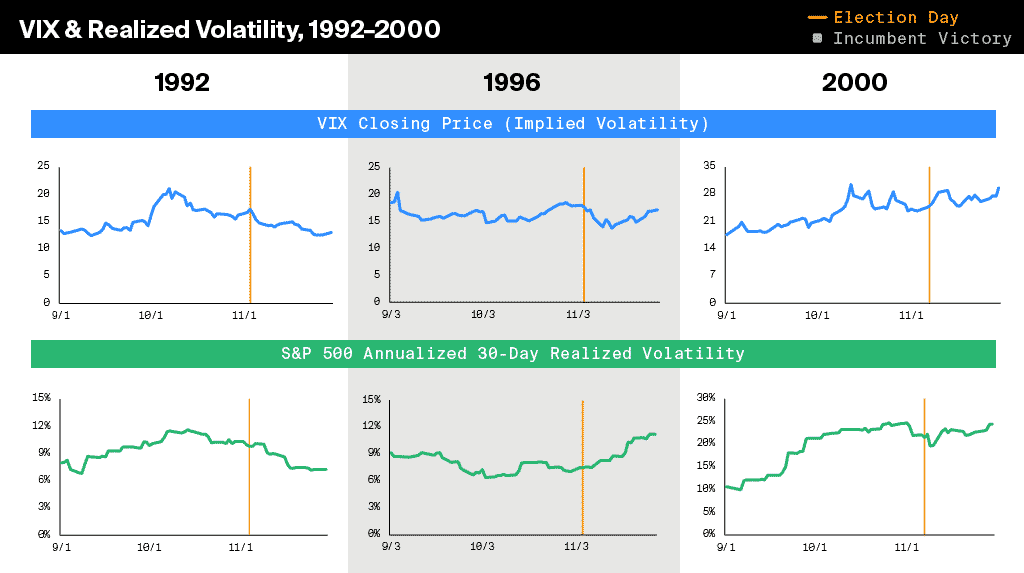
Markets during elections that featured an incumbent victory (’96, ’04, ’12) lacked a clear trend in implied volatility, with elections in ’96 and ’04 experiencing a subsequent drop in implied volatility in the days following the election and ’12 experiencing a slight uptick in volatility. Similar to non-incumbent elections, there was no clear correlation in actual realized market volatility.
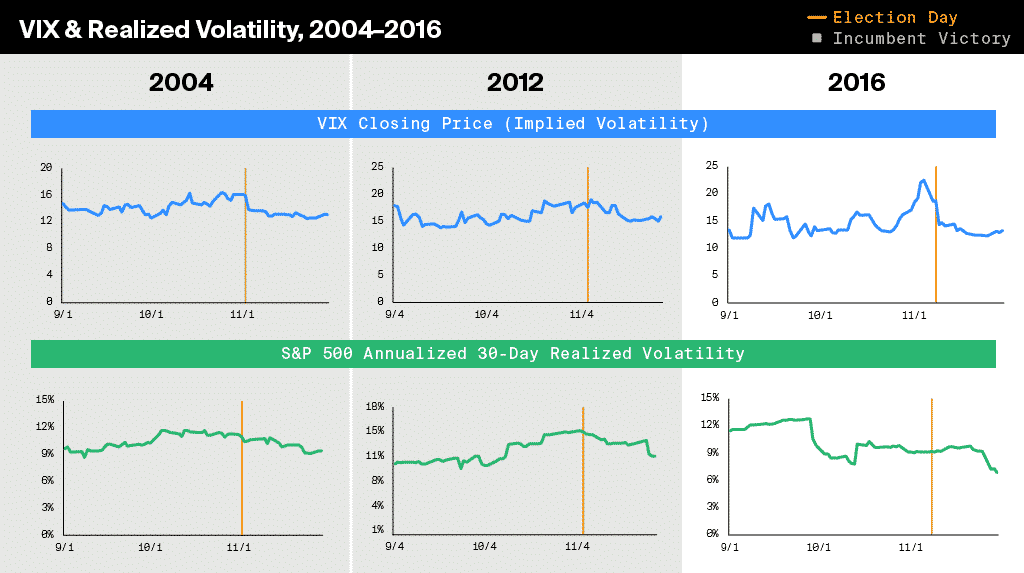
It is not until analyzing individual stock volatility that a trend in realized volatility becomes discernible.
Through an analysis of the industries highly impacted by candidates’ proposed policies in the 2016 general election and 2020 primary election, it is clear that election results can spike volatility for specific companies that could be impacted by potential policy changes. These individual volatility spikes do not, however, always translate into broad market volatility.
2016 General Election
In his 2016 campaign, President Trump pledged to revive the U.S. coal and steel industries. His victory sparked a sharp rise in realized volatility for these stocks.

Stocks of companies affiliated with transporting coal and supplying machinery for mining also experienced sharp spikes in realized volatility.
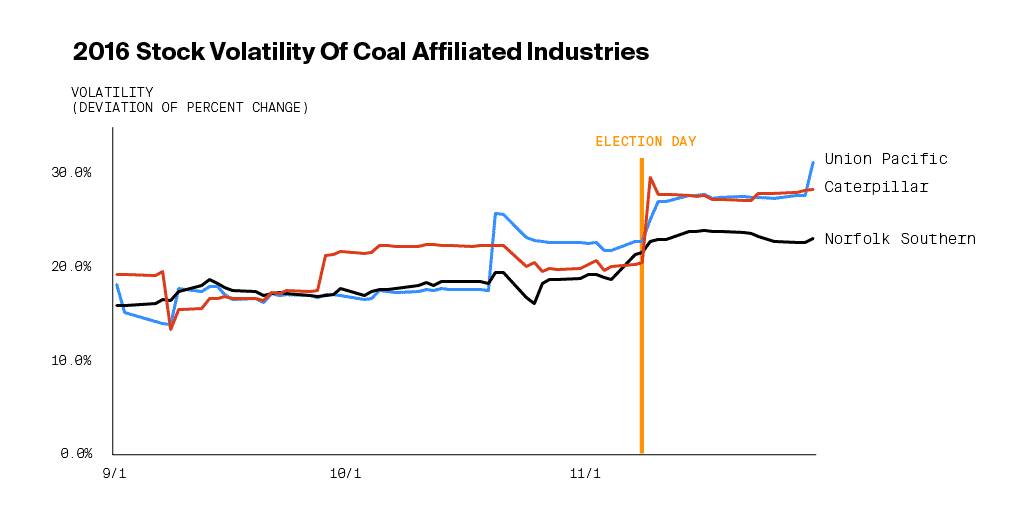
Facing the prospect of a reduction in government support from a new administration, renewable energy stocks experienced greater volatility following the 2016 election.
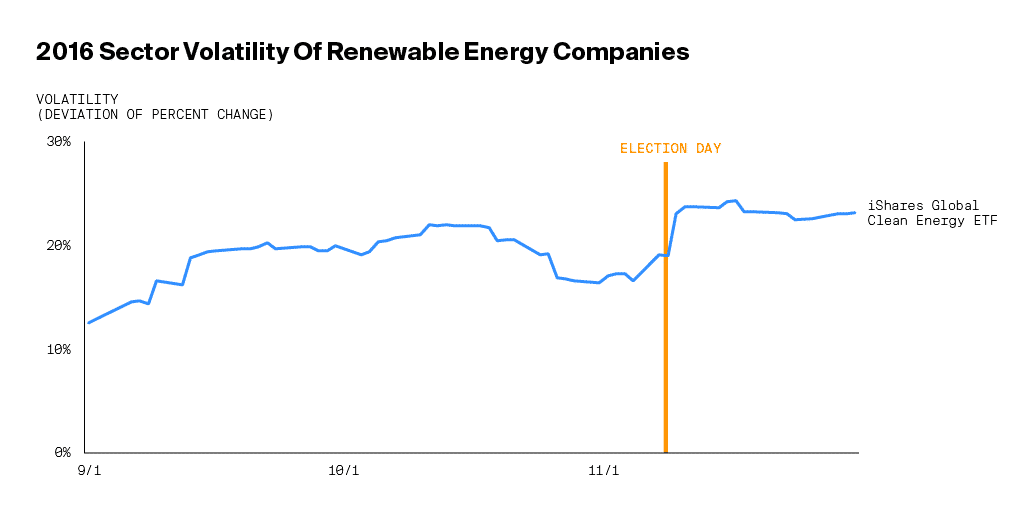
2020 Democratic Primary
Specific sectors of the economy can also experience volatility surrounding primary elections. For example, spikes in volatility in health care equities corresponded with both the New Hampshire primary and Super Tuesday.
The central position of health care in the 2020 Democratic primary, the uncertain fate of the party’s nomination, and the primary’s potential impact on the general election outcome and policy implementation all likely contributed to an uptick in health care stock volatility.
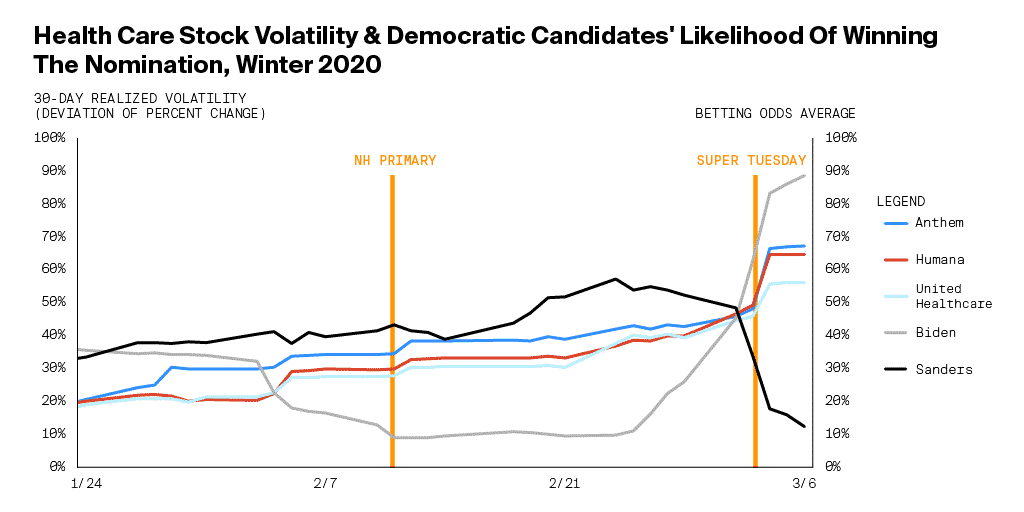
The 2020 election is already unlike any other and its market impact is still unclear, but by looking back at the trends of past elections we can begin to try and make sense of what may come in markets in the months ahead. Analysts and commentators should resist the urge to predict doom or euphoria for broad equity markets as the 2020 results roll in.
Sources: Bloomberg Terminal, YahooFinance!, Real Clear Politics
Methodology: Realized volatility is an historical metric measuring past market fluctuations. This is different from implied volatility, which measures investors’ expected future volatility.
Realized Volatility Calculation: Volatility is determined by taking the standard deviation of the percent change of S&P 500 closing prices and multiplying the square root of the average number of annual trading days.
Implied Volatility Calculation: The Chicago Board Options Exchange produces the real time VIX index to measure investors’ expected volatility over the upcoming 30 days.